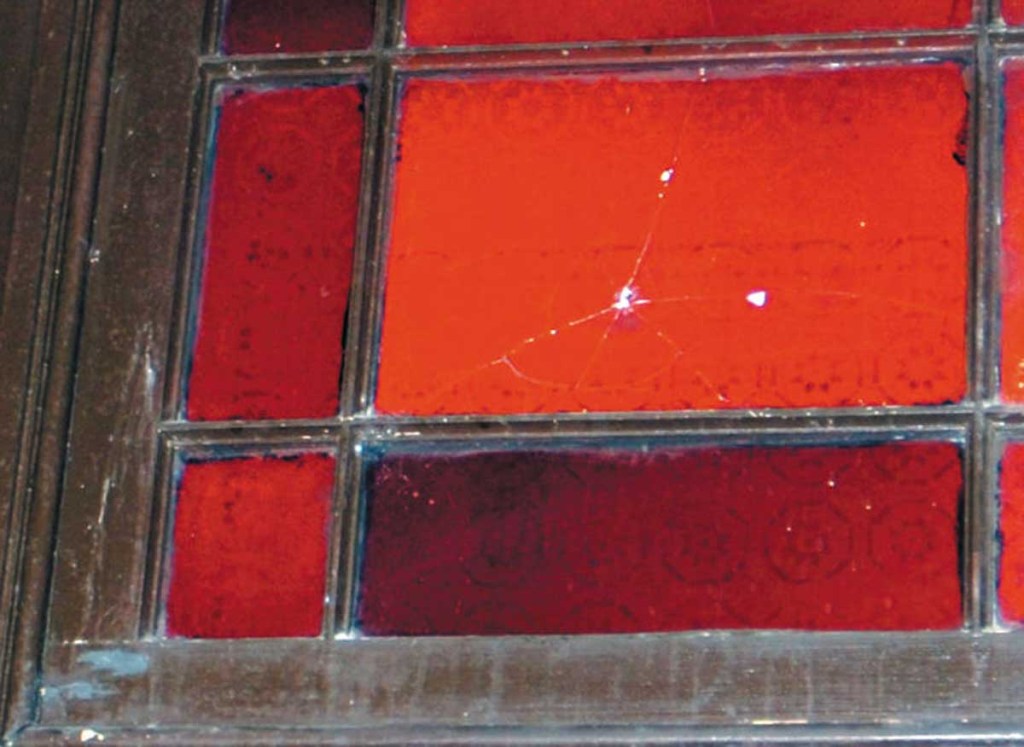Inzer House: Preserving History in Ashville
Published 10:11 am Wednesday, January 28, 2009

- Bullet holes above the front door from Yankee attack on Judge Inzer.
In 1866, Judge John Washington Inzer moved into what would become the historical Inzer Museum in Ashville. In the months that followed, Inzer got into an argument with a Yankee officer during reconstruction and the officer fired at him. “Yankees could kill civilians without recourse during Reconstruction. Reconstruction was 12 of the worst years the south has had outside of the war,” Benjamin Hestley said. The blasts missed Inzer and pierced the glass above the door. To this day visitors can still see the rays of light that sneak through the three holes of the ruby red transom glass in the classic Greek revival architecture home.
Inzer was born in Georgia and first came to Talladega in 1854. It was there that he studied law before opening a law office in Ashville in 1856. He served as St. Clair County’s representative to the Secession Convention in Montgomery on January 1861, and at 26 years old he was the youngest delegate to sign the Ordinance of Succession. Inzer was against the ordinance at first but was persuaded. He reached the rank of lieutenant colonel in the Confederate Army and he helped to write the state’s new constitution in 1875. He served in Montgomery as a senator in 1873 and 1900. Later, he would take the reins as a probate judge and circuit judge.
Moses Dean built the house, currently located at 229 5th Street, in 1852. According to the museum, Dean was one of Ashville’s first merchants. His business was directly across the street from the courthouse in a small cobblestone building. After Dean’s death in 1855, his wife, Eliza Dean, began the process of disposing his property and Inzer came to own the property.
Hestley, and William E. Watkins, along with several others make up The John W. Inzer Musuem, Inc. Board of Directors. Watkins is the historian of bunch and Hestley is the chairman. They are also members of the of Sons of Confederate Veterans (SCV) Ashville camp. These men and women have devoted and continue to devote countless volunteer hours to the restoration of this enduring Ashville landmark.
Nine volunteer Board of Director members operate the museum and the Inzer House receives additional support from volunteers in the community. The board’s mission is to “restore, maintain and operate the home for the education, use and benefit of the general public. The goal of the board is to expand museum membership, increase local and area involvement and support, and to develop a county wide educational program that will involve not only distribution of information and student visits to the museum, but also to supply programs to the schools of interested volunteers.”
Upon entering the museum in the daytime, the first thing you see if the ruby red sunlight produced by the special windows. “The ruby red transom glass was made of leaf gold. It’s dark on the outside and you can’t see in. It’s red on the inside and the light flows through,” Watkins said. The effect is a beautiful illumination.
The mens’ and womens’ parlors lie to the immediate left and right after entering.
Inzer’s wife, Sara Elizabeth Pope, and other ladies retired to the parlor in the evening to do needlework and chat. The ladies’ parlor features a fainting sofa. It appears to be a normal sofa missing one of its armrest. “This was in order for the ladies to hang their feet off one side. It actually folds out to a full sized bed. In the early 1800’s the ladies would come in, loosen up their girdles and relax,” Watkins explained. Everything in the middle class town house of the period is original. The “Doll of Secrets,” an antique child’s doll that can be black or white with a flip of the skirt, a sophisticated for its time oil lamp, and an ingenious cloth coffee percolator, all reflect the time passed.
The men talked and smoked in their parlor. “They say at night you can smell the cigar smoke that permeated the walls in the men’s parlor,” Watkins noted. The entire house is made up of 16-inch brick walls, from the foundation to the roof.
Paintings had to be hung by wires from the ceiling to hooks because of the brick walls and the weight of the frames. Wide doorways allowed women with hoop dresses to enter without hassle.
The last bedroom is close to being remodeled. Watkins said they take pieces of the old wallpapers and save them for historical purposes. “It’s hard to find anyone that does plaster now. We’ll re-plaster and repaint the room… that wallpaper in the other room is expensive.” The Ashville camp of the United Daughters of the Confederacy (UDC) made the curtains in the judge’s bedroom and in the archive room that also contains old tools, guns and memorabilia. A highlight of the room is the Confederate Seal featuring George Washington. “My wife is the president of the UDC and they all love this house. They’d live here if they could,” Watkins laughed.
Newspapers from as early as 1911 were found under Inzer’s rug in his bedroom. The papers helped with insulation below the small bed. “I can’t figure out how Judge Inzer slept in that bed at six-foot-two. He must have slept caddie cornered,” Hestley smiled. “Well, not everybody sleeps stretched out,” Watkins replied.
Miss Sally V. Inzer was the Judge’s granddaughter and she had an office in the house. Watkins said she worked for the government and there is a geography book on her desk that dates back to 1880. There is an old telephone in the office. A yellowed phonebook was found filled with two digit numbers. Sally Inzer died in the 1980s, the last time an Inzer occupied the home. The house and all its contents was later donated to the Ashville SCV camp.
Outside the Inzer Museum is a gazebo, an outhouse, the cook’s quarters and the coach house. “The gazebo featured a cooling well where the cooks could keep eggs, meats and cheeses until they were ready for them,” Watkins said. The outhouse has three seats in two stalls. “You be surprised how many people take pictures of this outhouse,” Watkins laughed. The cook’s residence is currently being used as storage and an entire wall holds just a portion of the Judge’s immense collection of law books. The cooking was done there in the summer and underneath the kitchen in the winter. A small, peculiar staircase in the kitchen corner made the transfer of food easier. In the basement is a large collection of antique bottles, wooden boxes, old tools and, of course, more books. “They saved everything,” Watkins said.
The Inzer Museum recently received a $22,500 grant from State Representative Dr. Jim McClendon (R-50) and Blaine Galliher (R-30) to further improve the museum.
New discoveries are found nearly every week at the Inzer Musuem. A recent span of steady rain unearthed another antique bottle. Who knows what else lies on the storied property waiting to be uncovered?
For an appointment to visit the museum call: (205) 594-5243 or (205) 594-2116. The museum offers educational tours, exhibits and other special events for school groups, civic organizations and the general public.




